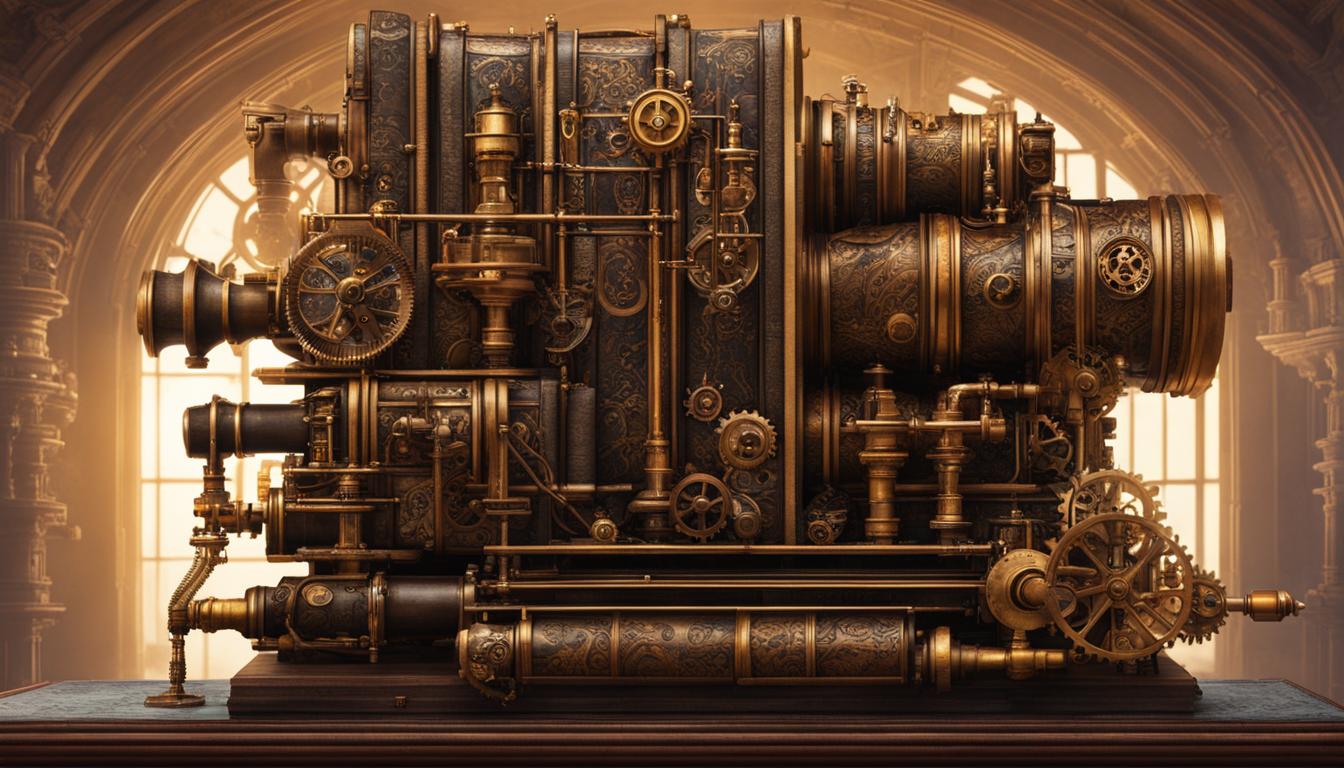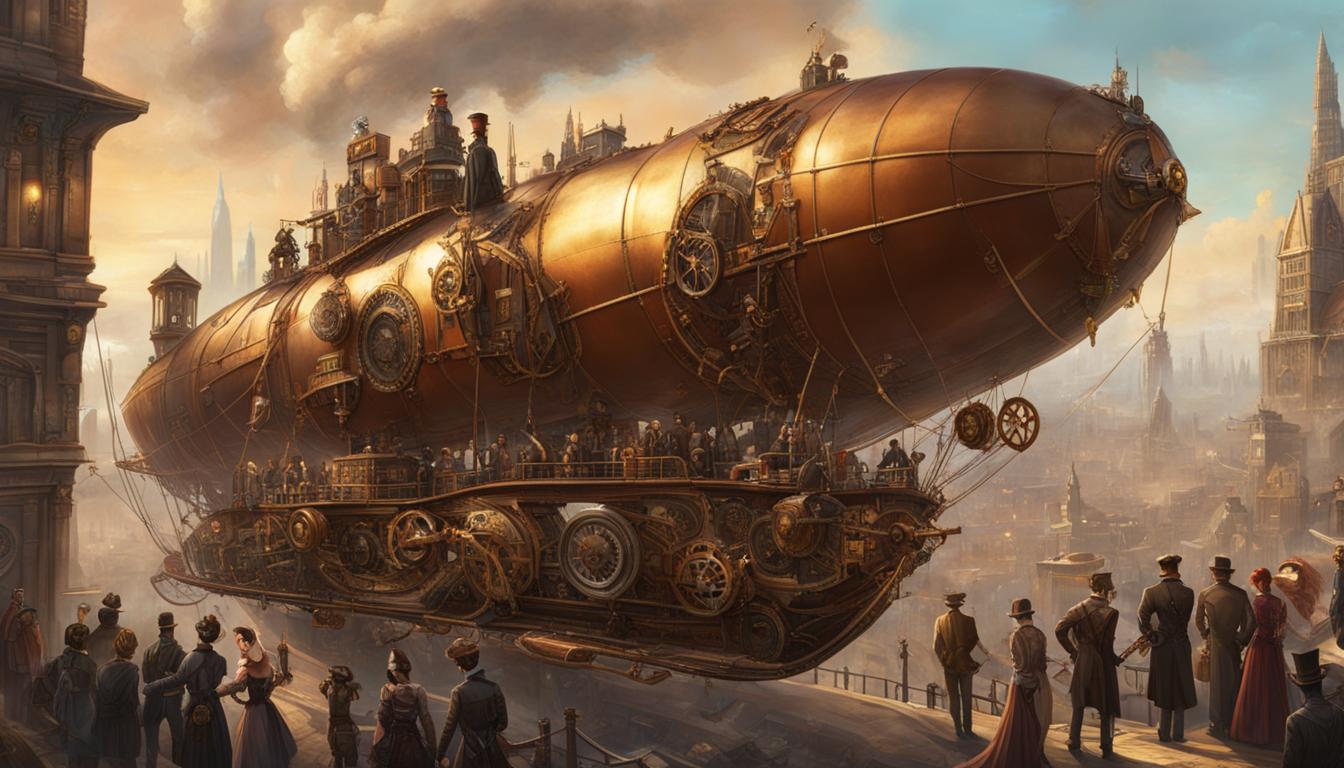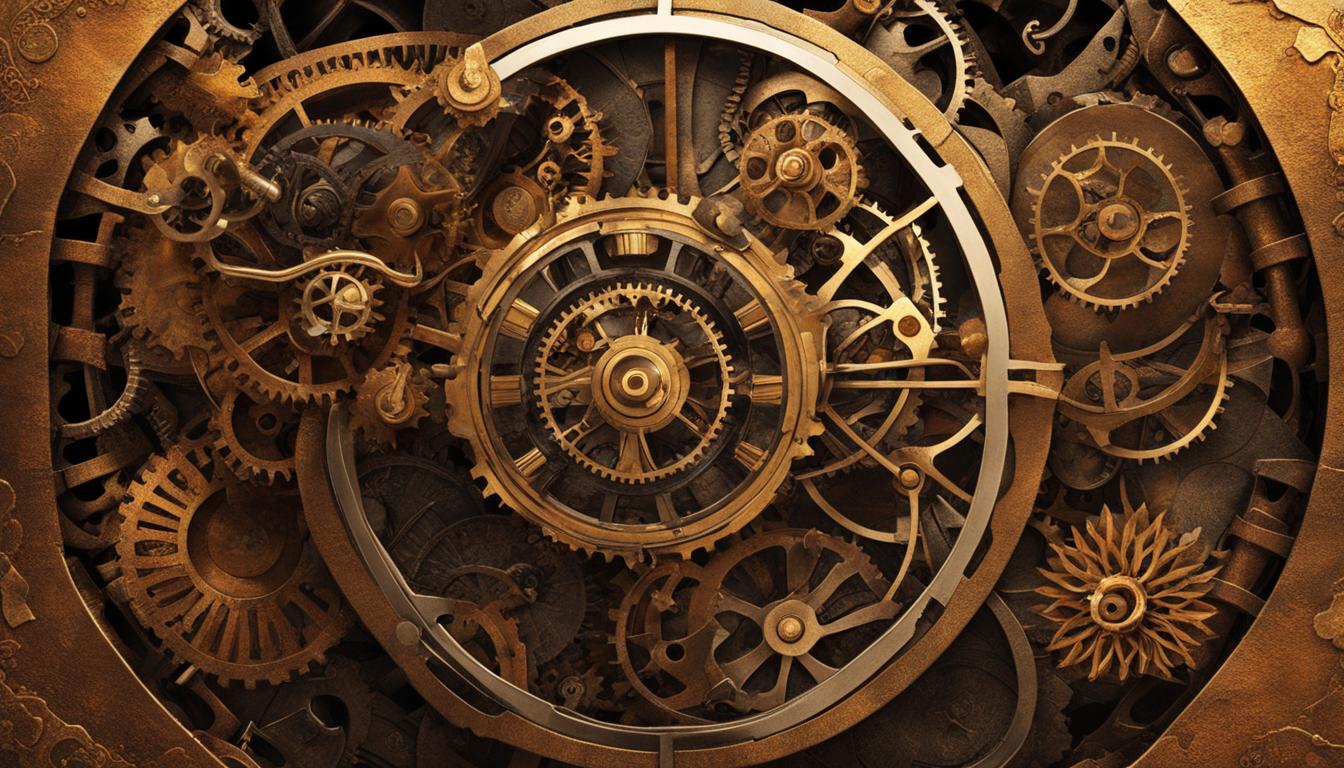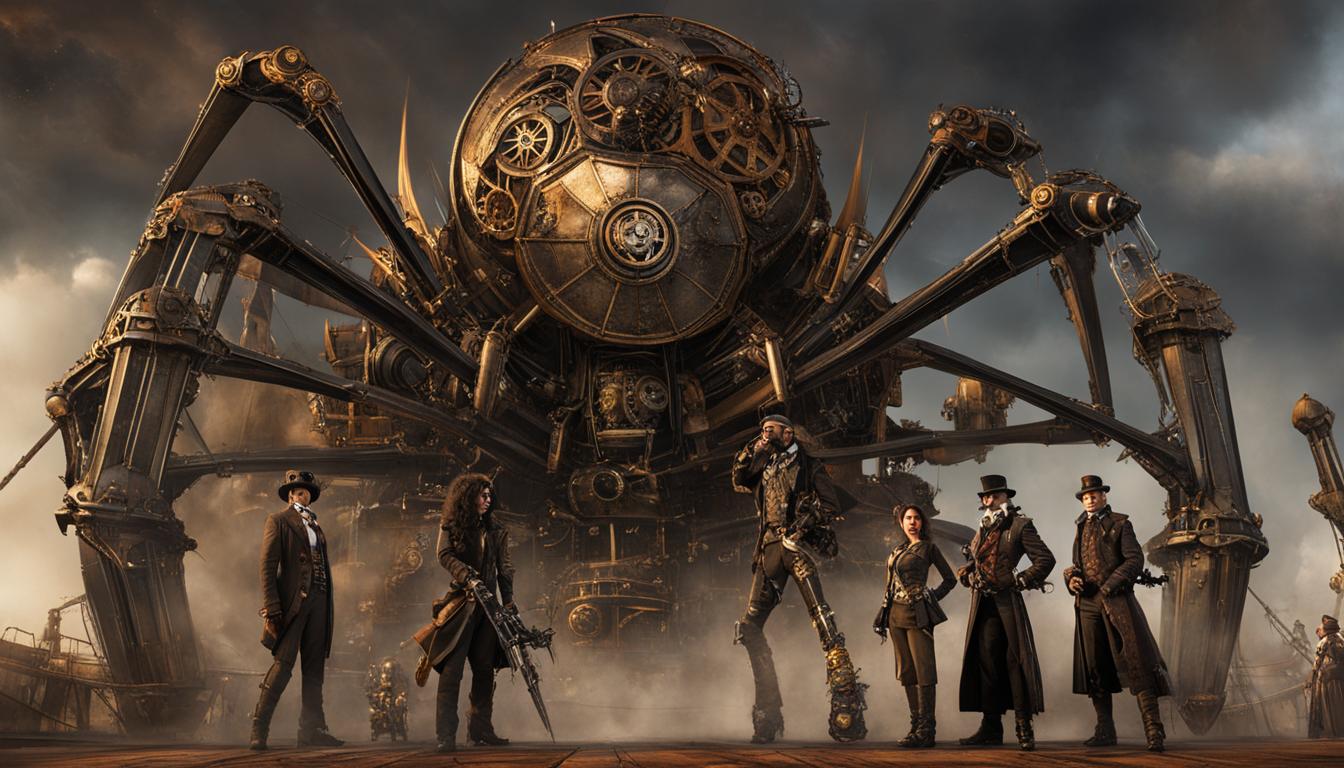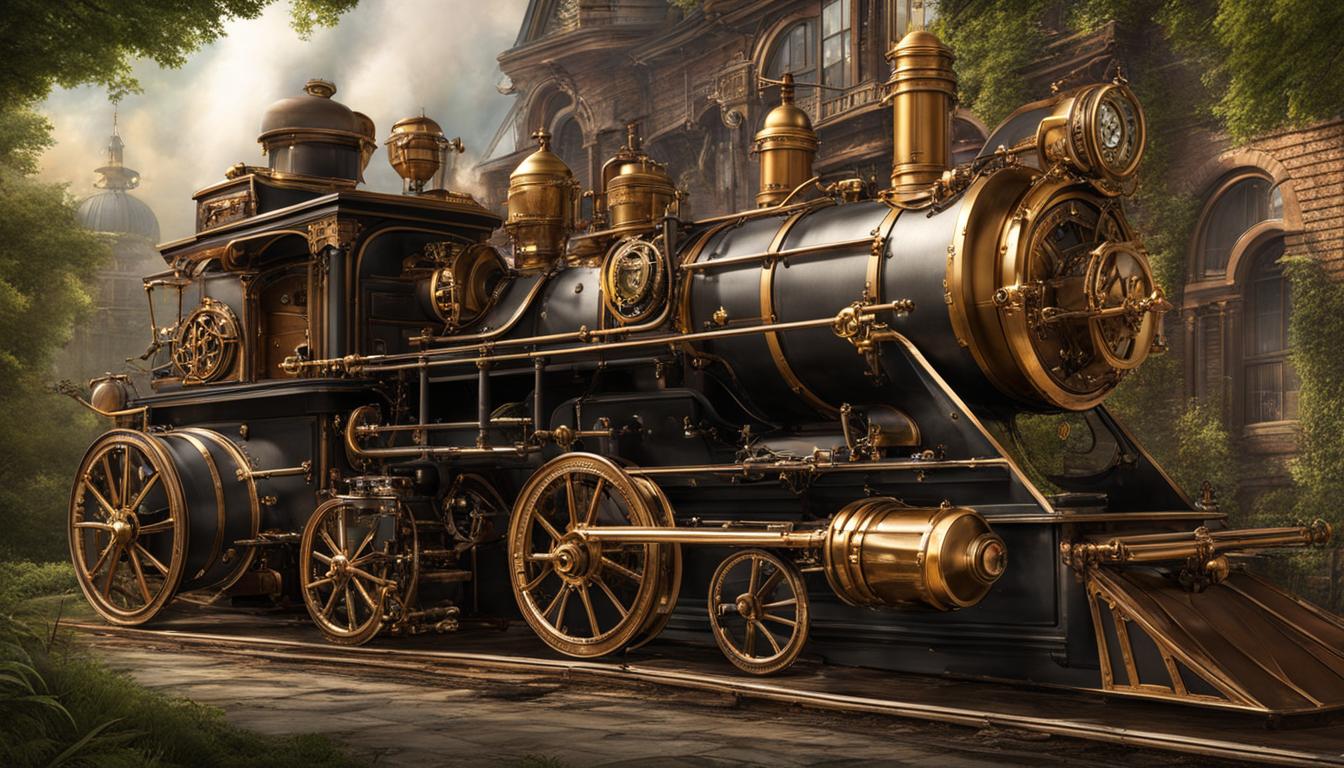Steampunk, the captivating cultural movement that encompasses literature, art, fashion, and film, draws its allure from the fusion of the Victorian era and futuristic concepts. At the heart of steampunk’s imaginative worlds lies the central role of science, shaping narratives that weave historical scientific breakthroughs with the boundaries of what is possible. By reimagining the past and infusing it with advanced technologies, steampunk creators craft mesmerizing tales that transport audiences to an alternate reality.
Key Takeaways:
- Science plays a significant role in shaping steampunk narratives, exploring historical scientific breakthroughs and pushing the boundaries of what is possible.
- Steampunk draws inspiration from the Victorian era and the Industrial Revolution, blending historical aesthetics with fantastical inventions.
- The interplay of science and magic blurs the lines between scientific possibility and fantastical elements in steampunk worlds.
- Steampunk often features scientific pioneers who drive societal changes and push the boundaries of knowledge and invention.
- Ethical considerations regarding scientific experimentation and the broader impact on society are explored within steampunk narratives.
The Victorian Era and the Industrial Revolution as Influences in Steampunk
Steampunk, with its blend of Victorian aesthetics and fantastical elements, takes inspiration from the historical context of the Victorian era and the Industrial Revolution. The Victorian era, known for its strict social hierarchies and fascination with science and exploration, provides the perfect backdrop for steampunk narratives. This era witnessed significant advancements in science and technology, such as the invention of the steam engine, which played a crucial role in shaping the Industrial Revolution.
The Industrial Revolution, characterized by the rise of steam-powered machinery and mass production, transformed society and became a defining feature of the Victorian era. Steampunk takes this industrial landscape and reimagines it, infusing it with imaginative technologies and inventions that are powered by steam and clockwork mechanisms. These fantastical machines blend seamlessly with the Victorian aesthetics, creating a unique visual experience.
Steampunk authors draw on historical scientific breakthroughs and achievements, such as James Watt’s steam engine and Charles Babbage’s analytical engine, and reinterpret them in ways that diverge from our known history. This alternate historical perspective allows for the exploration of what could have been if science and technology had taken a different path during the Victorian era. By combining historical elements with imaginative storytelling, steampunk creates captivating narratives that transport readers into a world where the boundaries of science and invention are pushed to their limits.
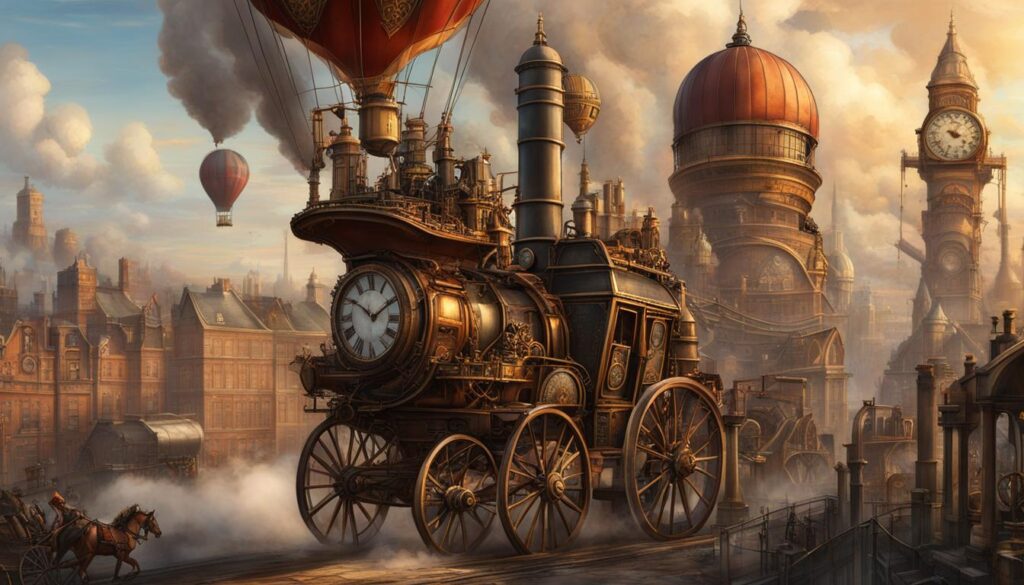
Table: Victorian Aesthetics and Industrial Revolution in Steampunk
| Victorian Aesthetics | Industrial Revolution |
|---|---|
| Gothic architecture | Steam-powered machinery |
| Bustle dresses and top hats | Mass production and factories |
| Ornate furnishings and decor | Rise of steam locomotives |
“Steampunk takes the best parts of the Victorian era and adds fantastical elements, creating a world that is both familiar and extraordinary.” – Josephine Belle, Steampunk Enthusiast
The Interplay of Science and Magic in Steampunk
Steampunk, with its blend of Victorian aesthetics and futuristic innovations, often incorporates the interplay of science and magic. This unique combination blurs the boundaries between what is scientifically possible and what is fantastical. In steampunk narratives, pseudoscience plays a significant role, allowing for the existence of impossible machines and gadgets powered by imaginary magical sources.
Steampunk creators embrace the fusion of science and magic, pushing the limits of scientific ethics and challenging conventional notions of what is possible. By intertwining these two elements, they create a captivating blend of technologies within their imaginative worlds, where the laws of physics can be manipulated in extraordinary ways.
“In the steampunk universe, machines can be powered by gears and steam, but they can also harness the energy of mythical creatures or tap into the unseen forces of magic,” says renowned steampunk author, Victoria Blackwell.
This fusion of science and magic is what sets steampunk apart, offering a realm of endless possibilities and captivating readers with its sense of wonder. It allows steampunk authors to explore the realms of imagination, unrestricted by the constraints of reality, and create intriguing narratives that transport audiences to fantastical worlds.
The Role of Pseudoscience in Steampunk Narratives
Pseudoscience, a key component of steampunk storytelling, serves as the bridge between science and magic. It provides a plausible explanation for the existence of fantastical technologies within the steampunk universe. These pseudo-scientific principles allow authors to explore the boundaries of scientific knowledge and challenge the limitations of what is considered possible.
From airships powered by mysterious energy sources to automatons possessing human-like qualities, steampunk narratives often rely on pseudoscience to weave together the fantastical and the rational. This incorporation of pseudoscience adds depth and intrigue to the stories, setting them apart from traditional science fiction or historical fiction.
| Steampunk Inventions | Pseudoscientific Explanation |
|---|---|
| Aetheric Communicator | Utilizes the properties of aether to transmit messages across vast distances |
| Time Manipulator | Harnesses the hidden forces of time and space to manipulate the flow of time |
| Alchemy Engine | Transmutes base metals into precious materials using alchemical principles |
These pseudoscientific explanations add an element of mystery and enchantment to the steampunk genre, capturing the imagination of readers and inviting them to explore the realms of science and magic intertwined.
Scientific Pioneers in Steampunk Stories
Steampunk narratives often feature characters who embody the spirit of scientific pioneers, pushing the boundaries of knowledge and invention. These characters, portrayed as brilliant inventors and eccentric geniuses, bring to life the Victorian era’s fascination with scientific advancements and exploration. With their knowledge and skills, they create remarkable machines and technologies that shape the steampunk world.
These scientific pioneers play a central role in steampunk stories, driving the plot forward and captivating readers with their ingenuity. They navigate the ethical implications of their creations, pondering the consequences of their scientific experiments on society. As the storyline unfolds, the societal changes brought about by their inventions become evident, sparking thought-provoking discussions about the impact of scientific progress on the world.
“I have always believed that the pursuit of knowledge should be matched with a sense of responsibility,” says Professor Eliza Harrington, a character in the popular steampunk novel ‘The Cogsmith’s Invention.’ “Invention and innovation are not merely acts of creation, but also acts of stewardship. We must harness the power of progress for the betterment of society.”
Steampunk’s Perspective on Scientific Advancements
Through their narratives, steampunk authors provide a unique perspective on scientific advancements. By reimagining historical contexts and integrating advanced technologies, they challenge conventional scientific principles and embrace a sense of wonder and possibility. Steampunk worlds defy the boundaries of science, allowing for extraordinary machines and gadgets powered by steam, clockwork, and even imaginary magical sources.
In this alternate reality, steampunk authors explore the fascinating intersection of science and imagination. By stretching the limits of what is scientifically possible, they invite readers to ponder the ethical dilemmas and societal implications that arise with the progress of scientific experimentation. Steampunk’s perspective on scientific advancements sparks curiosity and encourages us to question the impact of innovation in our own world.
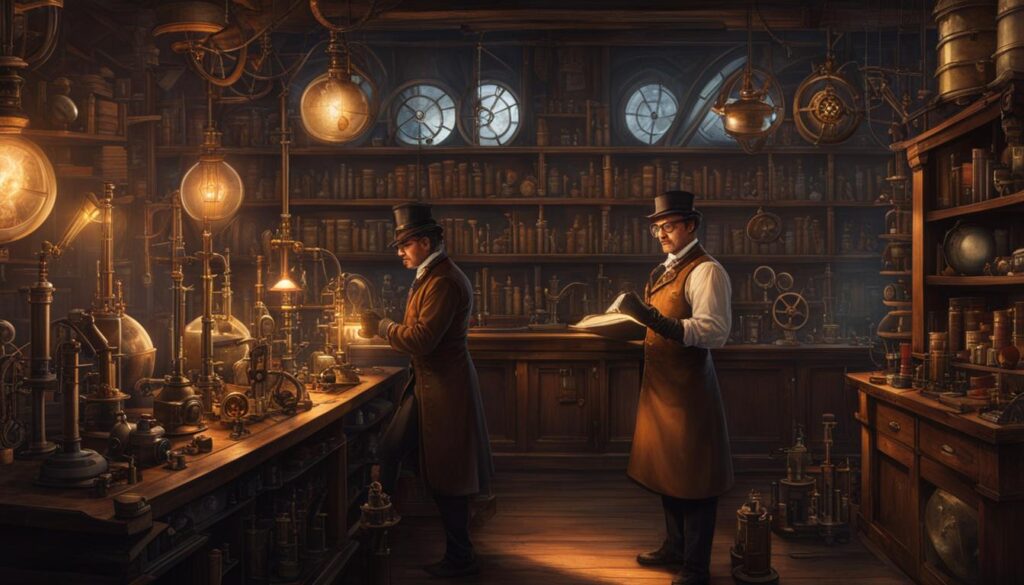
The Ethics of Scientific Experimentation in Steampunk
In the fantastical world of steampunk, scientific experimentation takes center stage, pushing the boundaries of what is morally acceptable. Steampunk stories often explore the ethical implications of scientific advancements and the transformative impact they have on society. Characters grapple with the consequences of their creations, opening up a thought-provoking dialogue on the responsibilities of scientists and the potential dangers of unchecked innovation. These narratives present a unique perspective on the delicate balance between scientific progress and the well-being of humanity.
Science-driven societal changes are a recurring theme in steampunk, showcasing how scientific breakthroughs can shape and reshape the fabric of society. As steam-powered machinery and imaginative inventions become integral parts of these stories, questions arise about the ethical responsibilities that come with scientific progress. Steampunk encourages readers to critically examine the potential benefits and drawbacks of pushing the boundaries of scientific experimentation. It prompts us to reflect on the greater implications of our actions and the importance of considering the ethical dimensions of scientific advancements.
“The man who successfully harnesses the power of steam is both a genius and a potential threat to humanity. It is within these ethical dilemmas that we find the heart of steampunk storytelling.” – Dr. Emily Thompson, Aether Journal
Steampunk offers a rich tapestry of narratives that challenge conventional scientific principles and explore the moral complexities of scientific progress. These stories remind us that the pursuit of knowledge must be tempered with ethical considerations to prevent unforeseen consequences. By weaving together historical contexts, imaginative technologies, and ethical dilemmas, steampunk compels its audience to engage with the difficult questions that arise at the intersection of science and society.
| Table: Comparing Ethical Dilemmas in Steampunk | Scientific Experimentation | Societal Impact |
|---|---|---|
| Dr. Victoria Caldwell’s Etheric Resonance Device | Unprecedented innovation powered by ethereal energy sources raises questions about harvesting and exploiting otherworldly forces. | Revolutionizes transportation and communication, but also disrupts traditional power structures and fuels social unrest. |
| Professor Benjamin Hartwell’s Automaton Rights Movement | Creation of highly advanced artificial beings sparks debates on sentience, individual rights, and the moral obligations of their creators. | Leads to the emergence of a new civil rights movement and challenges societal norms surrounding the treatment of non-human entities. |
| Madame Sophia Rousseau’s Transmutation Elixir | Development of an elixir that can transmute base metals into gold raises concerns about economic stability and the potential for widespread fraud. | Prompts economic upheaval as the elixir’s availability disrupts established financial systems and threatens the balance of power. |
In conclusion, steampunk’s exploration of the ethics of scientific experimentation invites readers to examine the intricate relationship between science, society, and morality. By embracing the fantastical and pushing the boundaries of what is scientifically possible, these stories serve as cautionary tales, urging us to consider the ethical responsibilities that come with scientific progress. Steeped in historical context and infused with imaginative technologies, steampunk demonstrates the power of storytelling to provoke thoughtful analysis and challenge our understanding of scientific ethics.
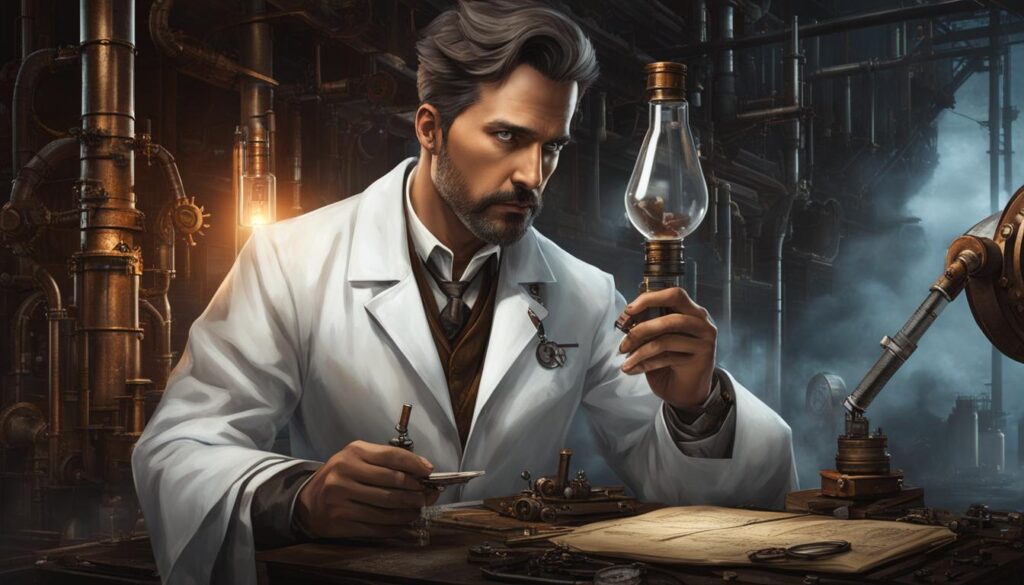
The Boundaries of Science in Steampunk Worlds
Steampunk, with its blend of history and fantasy, pushes the boundaries of science within its imaginative worlds. In these captivating narratives, the limitations of scientific principles are expanded, giving rise to extraordinary machines and gadgets that defy conventional understanding. By reimagining the past and introducing alternative timelines, steampunk invites readers to embrace a sense of wonder and possibility.
Table: Steampunk’s Perspective on Scientific Advancements
| Steampunk Element | Explanation |
|---|---|
| Pseudoscience | Steampunk often incorporates pseudoscience, allowing for the existence of impossible machines and gadgets powered by imaginary sources. This challenges the boundaries of scientific knowledge and opens up new avenues for storytelling. |
| Alternate Technologies | In steampunk worlds, advanced technologies coexist with Victorian aesthetics, creating a unique blend of the old and the new. This fusion of historical elements with futuristic concepts expands the possibilities of scientific innovation. |
| Magic and Science | The interplay between science and magic blurs the lines of what is scientifically possible in steampunk. This combination allows for feats that defy the laws of physics, creating a realm of limitless potential. |
Steampunk’s perspective on scientific advancements challenges traditional scientific principles, encouraging readers to explore the boundaries of what is possible. It celebrates the spirit of invention and imagination, inviting us to envision a world where scientific discoveries defy our expectations and push the limits of human ingenuity.
Unleashing the Imagination: Steampunk’s Creative Freedom
“Steampunk allows us to break free from the constraints of reality and dive into a world where the boundaries of science are stretched to their limits. It’s an invitation to unlock our imaginations and explore the infinite possibilities of what could have been.” – Emma Smith, Steampunk Enthusiast
In conclusion, steampunk’s perspective on scientific advancements challenges the conventional norms of science. By embracing elements of history, fantasy, and magic, steampunk authors craft narratives that inspire awe and wonder. They invite readers to question the boundaries of scientific knowledge while celebrating the creative freedom to explore new frontiers. In the realm of steampunk, the possibilities are as limitless as the imagination itself.
Steampunk’s Take on Scientific Ethics
Steampunk narratives delve into the ethics of scientific experimentation, presenting moral dilemmas that challenge the boundaries of scientific progress. In these intricate worlds of imaginative inventions and alternative histories, steampunk authors explore the consequences of unchecked experimentation and the responsibilities of scientists. The genre provides a platform to examine the societal impact of scientific advancements and the importance of responsible innovation.
One of the prevailing themes in steampunk stories is the exploration of the greater good. Characters are often faced with difficult choices that require them to weigh the potential benefits of their scientific creations against the potential harm they may cause. The interplay between science and ethics drives the narratives, prompting readers to reflect on the implications of scientific experimentation in our own world.
Challenging Conventional Notions
Steampunk’s unique blend of history and imagination challenges conventional notions of scientific ethics. The genre pushes the boundaries of what is scientifically possible by melding historical contexts with fantastical technologies. This blending of science and fiction allows for the existence of extraordinary machines and gadgets that defy the laws of physics.
“In a world where anything is possible, the ethical implications of scientific experimentation take on a new dimension,” says acclaimed steampunk author Victoria Blake. “Steampunk stories force us to confront the consequences of our actions and consider the potential dangers of unchecked progress.”
By examining the ethics of scientific experimentation, steampunk invites readers to reflect on the responsibilities of scientists and the impact of their creations on society. It encourages us to question the moral complexities of scientific progress and the importance of responsible innovation in shaping a better future.
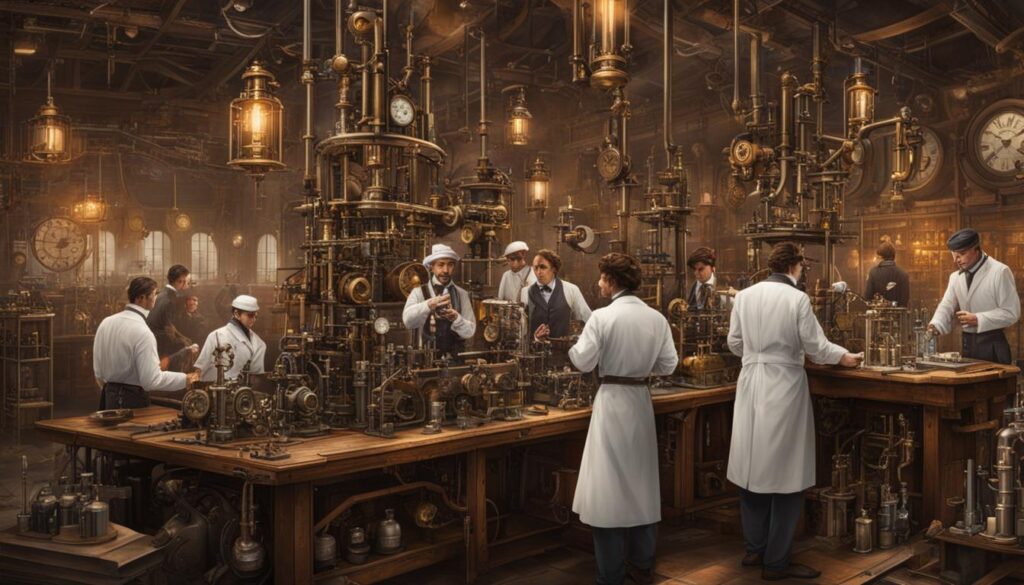
| Steampunk’s Perspective on Scientific Ethics | Key Insights |
|---|---|
| Exploring the consequences of unchecked experimentation | Raises awareness of the potential dangers of scientific progress |
| Examining the societal impact of scientific advancements | Encourages readers to consider the greater good when pursuing scientific innovation |
| Weighing the benefits and harm of scientific creations | Prompts reflection on the moral complexities of scientific ethics |
Steampunk’s take on scientific ethics offers a captivating exploration of the moral dimensions of scientific progress. Through its thought-provoking narratives, the genre invites readers to contemplate the responsibilities of scientists and the potential consequences of unchecked experimentation. By challenging conventional notions of what is possible and blending history with imagination, steampunk sheds light on the importance of ethics in shaping the future of scientific innovation.
Conclusion
Steampunk’s historical narratives beautifully intertwine with the central role of science, captivating audiences with their blend of history, imagination, and innovation. Drawing inspiration from the Victorian era and the Industrial Revolution, steampunk creates alternative worlds where scientific discoveries shape the course of history. From steam-powered machinery to fantastical inventions, steampunk pushes the boundaries of scientific ethics and challenges our perception of what is possible.
The interplay of science and magic within steampunk narratives adds an intriguing layer of mystery. Pseudoscience allows for the existence of awe-inspiring machines and gadgets powered by imaginary magical sources. This fusion of elements creates a unique blend of technologies that defy the laws of physics and ignite our sense of wonder.
Steampunk also raises important questions about the ethics of scientific experimentation. Characters grapple with the consequences of their creations and the societal impact of scientific progress. By exploring these moral complexities, steampunk authors encourage us to reflect on the implications of scientific advancement and the importance of responsible innovation.
In the world of steampunk, scientific discoveries play a vital role in shaping the narrative, serving as a catalyst for societal changes and raising thought-provoking ethical dilemmas. Through its blend of history, science, and imagination, steampunk invites us to explore the possibilities and consequences of scientific innovation in a world that embraces both the extraordinary and the familiar.
FAQ
What is steampunk?
Steampunk is a cultural movement that merges elements of the Victorian era with futuristic concepts, creating imaginative worlds filled with imaginative inventions.
How does steampunk explore historical contexts?
Steampunk reimagines historical contexts, such as the Victorian era and the Industrial Revolution, to create alternative historical narratives where the timeline diverges from our known history.
Does steampunk incorporate magic?
Yes, steampunk often blurs the lines between science and magic, incorporating pseudoscience and fantastical technologies powered by imaginary magical sources.
What kind of characters are featured in steampunk stories?
Steampunk stories often feature scientific pioneers who are portrayed as brilliant inventors and eccentric geniuses, using their knowledge and skills to create remarkable machines and technologies.
How does steampunk address the ethics of scientific experimentation?
Steampunk raises questions about the responsibilities and consequences of scientific advancements, exploring the moral complexities and societal impact of these developments.
Does steampunk push the boundaries of science?
Yes, steampunk pushes the boundaries of science by blending historical contexts with fantastical technologies, allowing for the existence of extraordinary machines and gadgets.
What is the takeaway from steampunk’s perspective on scientific ethics?
Steampunk encourages reflection on the ethical responsibilities of scientists and the potential dangers of unchecked experimentation, emphasizing the importance of responsible innovation.
How does steampunk combine history, science, and imagination?
Steampunk weaves historical contexts with the central role of science, while also incorporating imaginative elements that challenge conventional notions of what is possible.
Source Links
- https://www.historians.org/research-and-publications/perspectives-on-history/december-2018/steampunk-for-historians-its-about-time
- https://www.servicescape.com/blog/victorian-visions-your-guide-to-writing-steampunk
- https://scroll.in/article/1021734/steampunk-how-this-subgenre-of-science-fiction-challenges-the-beliefs-of-civilisational-progress

